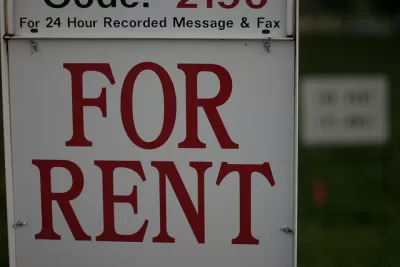Reports about the median rents rising or falling in a community garner a lot of attention, but it's a good idea to understand where the data is coming from.

Daniel Hertz of City Commentary has a warning for journalists using stats about average or median rents in a city—be aware that the information used to compile such statistics may be lacking significant amounts of data. Hertz writes that the numbers can often be skewed due to the absence of listings that never make it to Craigslist or other rental web sites.
For a number of reasons, just taking the average of all the listings you can find is likely to produce extremely skewed results, with numbers much higher than true average home prices. For one, many apartments, especially on the lower end of the market, aren’t necessarily listed in places that are easy to find—or at all. Instead, landlords find tenants with a sign on a fence or streetlight pole, local (and not necessarily English-language) newspapers, or just word of mouth.
Hertz cites the example of a rent report for the city of Chicago compiled by web site Zumper. Zumper's data skews toward the more expensive listings found in just a handful of neighborhoods, while the cheaper rental listings found in other neighborhoods are missing. Why? Hertz believes that the publicly available listings that web sites like Zumper are accessing are those on the higher end of the spectrum: "Zumper takes the median from its listings, without compensating at all for the fact that its listings are disproportionately concentrated in higher-end neighborhoods."
FULL STORY: Journalists should be wary of “median rent” reports

Alabama: Trump Terminates Settlements for Black Communities Harmed By Raw Sewage
Trump deemed the landmark civil rights agreement “illegal DEI and environmental justice policy.”

Study: Maui’s Plan to Convert Vacation Rentals to Long-Term Housing Could Cause Nearly $1 Billion Economic Loss
The plan would reduce visitor accommodation by 25% resulting in 1,900 jobs lost.

Planetizen Federal Action Tracker
A weekly monitor of how Trump’s orders and actions are impacting planners and planning in America.

Waymo Gets Permission to Map SF’s Market Street
If allowed to operate on the traffic-restricted street, Waymo’s autonomous taxis would have a leg up over ride-hailing competitors — and counter the city’s efforts to grow bike and pedestrian on the thoroughfare.

Parklet Symposium Highlights the Success of Shared Spaces
Parklets got a boost during the Covid-19 pandemic, when the concept was translated to outdoor dining programs that offered restaurants a lifeline during the shutdown.

Federal Homelessness Agency Places Entire Staff on Leave
The U.S. Interagency Council on Homelessness is the only federal agency dedicated to preventing and ending homelessness.
Urban Design for Planners 1: Software Tools
This six-course series explores essential urban design concepts using open source software and equips planners with the tools they need to participate fully in the urban design process.
Planning for Universal Design
Learn the tools for implementing Universal Design in planning regulations.
Caltrans
Smith Gee Studio
Institute for Housing and Urban Development Studies (IHS)
City of Grandview
Harvard GSD Executive Education
Toledo-Lucas County Plan Commissions
Salt Lake City
NYU Wagner Graduate School of Public Service




























